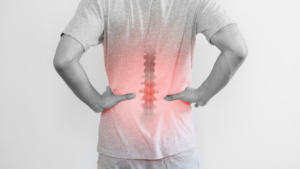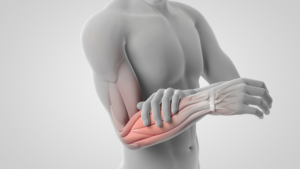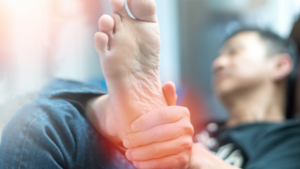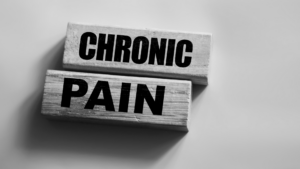Do you or a loved one experience chronic pain, limited mobility, and decreased quality of life even after undergoing back surgery? If so, there may be a condition called Failed Back Surgery Syndrome (FBSS) at play. FBSS is a common complication for people who have undergone various types of spine surgery for various spinal disorders.
While this difficult-to-treat syndrome typically occurs after lumbar spine surgery, it can also occur in the cervical and thoracic regions as well. Read on as we analyze the causes, symptoms, diagnosis, and treatment approaches available for patients affected by FBSS to help clarify this frustrating condition.

Failed Back Surgery Syndrome
fWhat is Failed Back Surgery Syndrome?
Failed back surgery syndrome occurs when patients experience persistent pain after undergoing spinal surgery. This pain can range from mild to severe and can be located in the same area where the pre-existing pain was before the surgery or even in an entirely new area. It is estimated that between 7% and 27% of all spinal surgeries result in failed back surgery syndrome.
Symptoms of Failed Back Surgery Syndrome
The symptoms of FBSS can vary widely, depending on the severity and location of the pain. Commonly reported symptoms include:
- Persistent back or leg pain
- Limited mobility or difficulty walking
- Numbness in the feet or legs
- Problems with bladder or bowel control
What Causes FBSS?
Failed back surgery syndrome can occur due to a variety of reasons, including scar tissue formation around the surgical site, nerve damage caused by the surgery itself, or undiagnosed underlying conditions that were not addressed during the original operation. Whatever the cause may be, it is essential to know that there are treatment options available to help manage your symptoms and reduce your pain.
Diagnosing Failed Back Surgery Syndrome
To diagnose FBSS, your doctor will ask about the history of your back pain and take a physical examination to assess any spinal instability. They may also use imaging studies such as an x-ray, CAT scan, or MRI to get an idea of what is going on in the spine. Other tests, such as an electromyogram (EMG) or nerve conduction study, may be done to measure how well your nerves are working.
Treatment Options for Failed Back Surgery Syndrome
There are several treatment options available for those suffering from FBSS, including:
- Physical Therapy – Physical therapy is often recommended as one of the first steps in treating FBSS. It focuses on strengthening weak muscles, increasing flexibility, improving posture, and teaching proper body mechanics to help reduce pain levels over time.
- Medication – Your doctor may prescribe pain medications as part of your treatment plan for FBSS, including non-steroidal anti-inflammatory drugs (NSAIDs), muscle relaxants, or opioid medications such as oxycodone or hydrocodone. Your doctor will determine which medication(s) best suits your individual needs.
- Psychological Therapy – Cognitive behavioral therapy (CBT) is beneficial in treating chronic pain conditions such as FBSS. CBT helps patients develop healthy coping skills to deal with their pain more effectively and learn how to better manage stress levels.
- Spinal Cord Stimulation – Spinal cord stimulation (SCS) involves using electrical signals delivered through implanted electrodes placed near nerves within the spinal cord that have been identified as being involved with the patient’s chronic pain condition. SCS works by blocking or decreasing nerve signals associated with pain from reaching the brain.
- Alternative Treatments: In addition to traditional treatments such as medications and physical therapy, alternative treatments may be useful in treating FBSS symptoms. These include acupuncture, chiropractic care, yoga/meditation techniques, biofeedback training (a technique used to teach the body how to control its responses), and hypnosis techniques (which may help patients learn how to better cope with their chronic pain). While these alternative treatments cannot completely cure FBSS, they may provide additional relief when combined with traditional treatments like medications or physical therapy.
Get the Help you Need!
Failed back surgery syndrome (FBSS) is a very real phenomenon that can happen to anyone who has had spine surgery. FBSS often leads to chronic pain and can be extremely difficult to manage. If you or someone you love is struggling with FBSS, know that help is available. At Progressive Pain Management, we specialize in treating patients with FBSS and other complex cases of chronic pain.
We offer a wide range of treatments, from medication management to interventional procedures, and our team will work with you to create a customized treatment plan that fits your needs. Please fill out the form below to contact us today to learn more about how we can help you find relief from your chronic pain.
Arm and shoulder pain can be uncomfortable, inconvenient, and have a significant hindrance on everyday life if it goes without treatment. Sometimes the cause of arm and shoulder pain may be identifiable, resulting from a dislocation, separation, or prior injury. But sometimes, the cause of this pain can be a result of an underlying condition such as arthritis, tendonitis, or even gallbladder trouble. Regardless of the cause, many options are available to patients to treat arm and shoulder pain. Below is a list of some causes, non-invasive, and minimally invasive treatment options for those experiencing arm and shoulder pain.

How to Treat Arm and Shoulder Pain
Causes of Arm and Shoulder Pain
It goes without saying that accidents can cause a variety of injuries to the arm and shoulder. Some of these commonly seen injuries include…
- Brachial Plexus Injury-Usually resulting from sports, auto, or motorcycle accidents, brachial plexus injuries occur when the nerves that send signals from the spinal cord to the arm and shoulder are compressed, stretched, or torn. Symptoms include numbness down the arm, weakness, and lack of arm movement.
- Dislocation-dislocation of the shoulder or elbow is an obvious form of injury that occurs when the joint is forced out of alignment or overextended. Distortion of the joint along with pain is a clear identifier of a dislocation.
Arm and Shoulder pain can also be caused by various pain conditions, including, but not limited to:
- Bursitis-Commonly known as joint inflammation, bursitis affects the fluid-filled sacs also known as bursae’s that cushion the bone, muscle, and tendon surrounding a joint. The shoulder, elbow, and hip are the most common areas where patients experience bursitis.
- Tendinitis-This specific inflammation of the tendon is commonly known as tennis elbow, golfer’s elbow, or pitcher’s shoulder. This is the irritation of the tendons that attach bone to muscle.
- Rheumatoid Arthritis-A chronic inflammatory disorder, rheumatoid arthritis is known for causing a painful swelling that affects the lining of joints. Tender, swollen joints, fatigue, and joint stiffness are common markers of this condition.
Treatments For Arm and Shoulder Pain
If you find yourself experiencing pain in your arm and/or shoulder, there are many treatment options available to you.
- Follow RICE measures…
- Rest-avoid strenuous activity and take a break from any movements that activate the pain
- Ice-apply ice for 15-20 minutes up to three times a day
- Compression-if necessary, use a compression bandage to help reduce swelling
- Elevation-elevate arm if possible to aid in reducing any swelling
- Take an anti-inflammatory such as Ibuprofen or Acetaminophen to help reduce pain and inflammation
- Corticosteroid injections are anti-inflammatory injections that your doctor can turn to for a more aggressive form of pain management
- Newer advancements in treatment suggest that the injection of NASHA hyaluronic acid is also effective in treating arm and shoulder pain, specifically in patients with osteoarthritis
It is important to note that severe arm and shoulder pain that comes on suddenly and is accompanied by fullness in your chest or any chest pain should receive immediate medical attention to rule out the cardiac arrest. However, the suggestions above should be considered as a first line of treatment for common forms of arm and shoulder pain. Of course, everyone responds differently to different types of treatment. If the pain does not go away or seems to worsen, contact your doctor and consider other forms of treatment. Depending on the cause, physical therapy or surgery may be necessary.
If you live with arm and shoulder pain, the team at Progressive Pain Management can help determine the root cause of pain and create a treatment plan. Fill out the form below to contact our team today!
If you’re suffering from chronic knee pain, you know that it can significantly limit your daily activities. Chronic knee pain can be debilitating and can prevent you from living your life to the fullest. From simple actions like taking a walk around your neighborhood to more strenuous duties like playing sports or running, an aching knee can keep you grounded.
But don’t give up hope! Understanding the underlying causes of chronic knee pain – and finding ways to alleviate it – is key to enjoying an active lifestyle. Also, there are many treatments available that can lessen and even possibly eliminate the debilitating effects of chronic knee pain. Read on to learn more about how these treatments can restore your life free from constant knee pain!

What is Chronic Knee Pain?
Chronic knee pain is classified as any pain in the knee that lasts three months or longer.
Symptoms
The symptoms vary from person to person and may include:
- Constant or intermittent pain
- Swelling and tenderness
- Loss of range of motion in the knee
- Redness and warmth around the affected area
- Stiffness
- Locking sensation
- Itching and burning
Causes of Chronic Knee Pain
The underlying causes of chronic knee pain can include:
Arthritis
Arthritis is the most common causes of chronic knee pain. Arthritis can refer to any condition that affects the joints, and it can range from mild discomfort to severe, debilitating pain. Osteoarthritis, also known as degenerative joint disease, is caused by excessive wear and tear on the cartilage between joints. Rheumatoid arthritis is another type that occurs when your immune system attacks your joints, causing swelling and damage to the cartilage and bones in your knees.
Tendonitis or Bursitis
Tendons are thick bands that connect muscles to bones in the body, while bursae are fluid-filled sacs that act as cushions between bones, muscles, and tendons. When these become inflamed due to injury or overuse, they can cause chronic knee pain. Tendonitis usually occurs when tendons become irritated due to repetitive use or overuse, while bursitis occurs when bursae become infected or irritated by nearby tissues.
Meniscus Tears
Your meniscus is a semicircular piece of cartilage located between your thighbone and shinbone inside your knee joint. A tear in this cartilage can occur due to trauma or age-related wear and tear, leading to sharp pains in the affected area. This type of injury often requires surgery if it does not heal on its own with rest and physical therapy.
How to Treat Chronic Knee Pain
There are several things you can do to improve your quality of life and reduce the severity of your chronic knee pain; these include:
Physical Therapy
Physical therapy is a great treatment for chronic knee pain that can help to improve mobility, reduce swelling and inflammation, and strengthen the muscles around the joint. Exercises such as stretching, strengthening, and range of motion exercises can be beneficial in relieving symptoms while also helping to prevent future injuries.
Over-the-Counter Medications
Over-the-counter medications such as nonsteroidal anti-inflammatory drugs (NSAIDs) are commonly used to treat chronic knee pain by reducing inflammation and providing short-term pain relief. However, these medications should only be taken under a doctor’s supervision and may not be suitable for everyone.
Complementary Therapies
Complementary therapies such as acupuncture, massage, and yoga can all be beneficial in reducing chronic knee pain. These treatments can help to relax the muscles, improve circulation and reduce stiffness in the affected area.
Surgery
Surgery may be necessary when other treatments are ineffective in relieving chronic knee pain symptoms. Surgery typically repairs damaged ligaments or cartilage within the joint and may involve arthroscopy (a minimally invasive procedure) or open surgery (where larger incisions are required). Regardless of the type of surgery performed, it is important to follow a physical therapy program after surgery to ensure proper recovery and rehabilitation.
Rest and Relaxation
One of the best things you can do for yourself if you have chronic knee pain is to rest and relax as much as possible. This means avoiding activities that strain your knees or aggravate them further, such as running or jumping. Instead, focus on low-impact activities like walking, swimming, or biking. These types of activities will help strengthen the muscles around your knees without causing further damage or discomfort.
Long-Term Effects
Chronic knee pain can cause severe discomfort and negatively impact your quality of life. It is important to understand the long-term effects of chronic pain, such as:
- Loss of mobility
- Difficulty performing daily activities
- Depression
- Anxiety
Get Treatment for Your Knee Pain!
When it comes to treating chronic knee pain, there is no one-size-fits-all solution. Everyone’s pain levels and needs are unique, so finding the right combination of treatments to reduce your pain and improve your quality of life is essential.
If you’re suffering from chronic knee pain and want to learn more about what treatments are available, contact Progressive Pain Management and speak with a trained medical professional. We’ll work together to create a personalized plan that fits your lifestyle and works toward reducing your overall pain. To get started, fill out the form below to contact us today!
People have very different opinions on the cooler temperatures – either they love it, or dislike it. However, regardless of personal feelings, a degree drop affects the body similarly in everyone. A change in weather requires the body to function differently to conserve heat.
Those with chronic conditions and weakened systems can suffer, resulting in fatigue, worsened pain, and even immobilization. 92% of patients suffering from chronic pain believe their symptoms are exaggerated when the weather gets colder. Being aware of the impact of colder weather on your body can help reduce the pains of winter.

How Cooler Weather Can Affect Chronic Pain
Why A Drop in Temperature Results in Greater Pain
Despite a definitive, scientific relationship between cold weather patterns and chronic pain symptoms, patients report the changes their body experience when barometric pressure changes due to cold fronts and humidity changes.
Most of the reported pain symptoms result from swelling of joints and their surrounding tissues. When barometric pressure drops due to bad weather, the air pressure pushes with less force against joints. This allows the tissues to expand, which applies greater pressure to the joints. Patients with arthritis and fibromyalgia report aggravated pain.
Reduced temperatures can cause muscle stiffness, which makes moving and daily activities painful. However, remaining inactive leads to even greater pain. Spasms are more likely to occur when muscles are stiff and tight, leading to intense discomfort and pain. In patients with fibromyalgia, shortened muscles, caused by temperature drops in energy-deficient muscles is the main cause of pain.
For some patients, their chronic condition may be so severe that even a minor temperature change can result in worsened symptoms. It may be their first response to depend on a heating device, such as a heated blanket or hot water bottle. However, this can also cause painful side effects. Weakness, nausea, and changes in brain activity can result from overheating.
In patients who suffer from pain due to oversensitive nerves, the colder temperatures can cause widespread muscle and joint pain. An increase in nerve receptivity causes this. Cold weather negatively influences nerve conduction, so any pre-existing nerve damage becomes more noticeable.
Ways to Reduce Pain in Cooler Weather
Chronic pain patients can utilize a variety of methods to fight weather-related pain. Simple actions and changes to their daily lifestyle help keep the body warm and reduce pain caused by lower temperatures.
- Boost Your Vitamin D
Vitamin D is essential to maintaining energy and mindset. During the winter, it is common to battle seasonal depression and feeling slower due to reduced exposure to sunlight. Retaining higher levels of Vitamin D is important to help the body function properly and aids in reducing pain and stiffness. You can increase your Vitamin D intake by adding fatty fish and seafood to your diet, trying a UV light, or taking a supplement.
- Reduce Alcohol Intake
Winter alcoholic beverages may seem like they provide a cozy, toasty sensation, but they can actually lower body heat. Alcohol causes blood vessels to dilate, resulting in heat loss. Instead of having an alcoholic nightcap, try sipping on herbal tea to warm up and relax your body.
- Stay Active
Even if you can’t exercise outside, getting 30-45 minutes of cardio, strength, or flexibility training each day is recommended. Low-impact exercises such as yoga or tai chi help stretch the muscles and reduce mental stress. Cardio activities such as a treadmill or elliptical build muscle while increasing your heart rate.
It is important to remember to consult with your doctor before beginning any exercise routine. Even mild chronic pain conditions can be aggravated by overexertion. A physician can help determine appropriate exercises and stretches to combat your specific pain. Contact Progressive Pain Management by filling out the form below.
Various conditions, diseases, deformities, or injuries cause foot pain. Medications are a common approach to getting relief, but many options don’t involve pills or taking medicine.
Causes of Foot Pain
Diseases, viruses, fungi, and bacteria can cause foot pain, but one of the most common causes of foot pain is arthritis. Pain in the feet is associated with overuse of ligaments or nerve injuries. These are some other common causes for foot pain:

Foot Pain Causes, Home Remedies, and Treatments
- Ingrown toenail
- Plantar warts
- Athlete’s foot
- Diabetes
- Systemic diseases – such as lupus, gout, and rheumatoid arthritis
- Ill-fitting shoes or high heels
- Tendonitis
- Bone Spurs
If you experience foot pain, seeing a specialist is best. Delaying treatment can result in complications, chronic pain, or long-term disabilities.
How To Alleviate Foot Pain
OTC pain relievers can help inflammation and pain, but always consult your doctor before taking anything for your foot pain. Instead, treat yourself with at-home remedies to help minimize the pain.
RICE Method
Rest, ice, compression, and elevation.
If your foot pain is due to injury or overuse, resting it is one of the best ways to help lessen the pain. Rest will allow the tissues to heal and give your body time to process the injury. Ice should not be used for more than 20 minutes at a time. Wrap ice in a towel or plastic bag so it is not too cold on your skin.
Both compression and elevation help prevent swelling of the painful or injured area. Swelling can cause nerve fibers to stretch, causing more pain. Decreasing swelling often provides some degree of pain relief.
Foot Massage
Massages improve circulation, reduce tension, and can help alleviate pain. If you have foot pain, this is a good way to examine your feet, see if the pain worsens, and notice a problem before it worsens.
Trying a hydromassage is another way to help relieve pain. To do this, fill one large bowl or basin with cold water, and another with hot water. Place both feet in the cold water for 5 minutes, then moving to the hot water. Alternate every 5 minutes.
If your pain lasts longer than 5 days (with home treatments) and does not improve after a few weeks, schedule an appointment with a medical professional. Use the form below to get in touch with one the team at Progressive Pain Management.
Nerve blocks are a common form of therapy used to treat and manage chronic pain. Groups of nerves that cause pain to a particular region or area of the body can typically be blocked via injections of medication also known as nerve blocks. These nerve blocks are numbing substances that numb the nerves signaling a patient’s pain.

Nerve Block Injections for Chronic Pain Management
Four Categories Of Nerve Blocks for Chronic Pain
Nerve blocks are typically categorized into four main categories. These four nerve block categories include: therapeutic, diagnostic, prognostic, and pre-emptive.
- Therapeutic nerve blocks are used to treat chronic pain and various pain conditions. These nerve blocks typically contain local anesthetic which can be used to treat acute pain. Studies have shown these nerve blocks effectively improve the quality of life for patients with chronic pain.
- Diagnostic nerve blocks are issued to identify the source of a patient’s pain. These blocks contain a lower level anesthetic that provides a duration of pain relief.
- Prognostic nerve blocks identify the prognosis of certain treatments. For example, a prognostic nerve block may be issued to determine if a permanent solution, such as surgery, would be a more successful route to alleviate the patient’s pain.
- Preemptive nerve blocks are unique in that they are used to prevent subsequent pain often seen as the results of a procedure. This includes symptoms such as phantom limb pain.
Nerve blocks are also broken down into more specific categories based on the type of pain or location of pain that the patient is experiencing. These specific nerve blocks are sympathetic, stellate ganglion, and facet joint blocks.
- Sympathetic nerve blocks are performed to determine if there is existing damage to the sympathetic nerve chain. This includes a network of nerves that run the entire length of the spine and are responsible for controlling the body’s involuntary functions.
- Stellate ganglion blocks are a type of sympathetic block that are also used to identify damage to the sympathetic nerves. However, stellate ganglion blocks are used more specifically to identify nerve damage to the head, neck, chest, and arms.
- Facet joint blocks are conducted in the facet joints of the spine and are also known as zygapophysial blocks. These are used to determine whether a facet joint is the cause of pain.
Nerve Blocks by Location
Nerve blocks can be injected in various areas depending on the cause and location of a patient’s pain. Some of the most common nerve blocks by anatomical location include…
- Trigeminal nerve blocks for Trigeminal Neuralgia (face)
- Subarachnoid and Celiac nerve blocks (abdomen and pelvis)
- Supraorbital nerve blocks (forehead)
- Cervical, Thoracic, and Lumbar epidurals (neck and back)
- Maxillary nerve block (jaw)
Side Effects of Nerve Blocks
While studies have shown that nerve blocks can be highly effective in treating chronic pain, side effects are always possible. Everyone’s body reacts differently to medical treatments, but common side effects may include soreness at the injection site, rash, itching, bleeding, elevated blood sugars, and extra energy. While this may not happen to everyone, it is important to contact your doctor if you begin experiencing side effects outside of what is considered normal or if you’re experiencing anything causing concern.
Nerve blocks are specifically for patients with nerve damage or neurological conditions such as Trigeminal Neuralgia or chronic back pain. Patients who do not have nerve damage may not see the results from nerve blocks. However, patients experiencing chronic pain from nerve damage can benefit greatly from nerve blocks. Be sure to talk with your doctor if you think that nerve blocks may be the best option to treat your chronic pain.
The team of Progressive Pain Management specialists help treat various conditions that can benefit from these types of nerve blocks. Fill out the form below to get started.
Chronic pain is primarily one of the prevalent conditions affecting approximately 1 in 5 adults in the U.S. A substantial number of these patients experience chronic neuropathic pain. Also, another research shows that neuropathic pain affects more women than men, with a pain frequency rate of 8% and 5.7%, respectively, in persons above 50 years. Even with this high rate of occurrence, many do not understand what it is and the treatment procedures. It has been referred to as a “hidden epidemic” due to its unpredictable nature.
Fortunately, intense neuropathic pain does not always indicate a life-threatening condition. Some people with neuropathy might have relatively minor and manageable symptoms with conservative treatment like medication or physical therapy. Here is all you need to know about different types of neuropathic pain and their treatment.

Neuropathic Pain and Treatment Options
What is Neuropathic Pain?
Neuropathic pain is caused by peripheral or spinal nerve damage that transfers information between the brain and spinal cord from the skin, muscles, and other body parts. The pain is usually described as shooting, burning, tingling, numbness, and pins and needles.
Despite having complex symptoms, lesions or diseases of the somatosensory system are major causes of neuropathic pain. It is often resistant and can be very intense. Other causes include:
- Alcoholism
- Cancer and cancer treatments
- Viral infections
- Diabetes
- Trauma or surgeries which damage the nerves
- Vascular malformations
- Shingles
Types of Neuropathic Pain
The different types of neuropathic pain vary with body parts and nerves affected. When one nerve is affected, it is called mononeuropathy, while damage on more than one nerve is called polyneuropathy. The different types of neuropathic pain and the body parts they affect include;
Peripheral Neuropathy
Peripheral neuropathy is a nervous disorder affecting your hands, feet, toes, arms, and legs. Often, people with peripheral neuropathy experience weakness in their muscles and reduced sensitivity in their skin.
PN differs from other nerve damage forms because it simultaneously affects multiple peripheral nerves. Even if one body part can send signals to the brain, another factor may be unfunctional.
Autonomic Neuropathy
Autonomic neuropathy is a condition that damages the autonomic nervous system. Often the damage is episodic and intermittent. This causes an inconsistent negative effect on the spinal cord signals. Problems with this system will lead to dry eyes, uncontrolled reflexes, and bladder function difficulty.
Focal Neuropathy
Focal neuropathy is a neurological disorder affecting one or more body parts. It is mainly caused by trauma or infection and affects muscles in an area close to the damaged nerve.
When you suffer from focal neuropathy, it is common for you to experience numbness, tingling, burning sensations, and even pain near the affected site. If you experience these symptoms and are unsure what they mean, visit an ophthalmologist or neurologist to find out more.
Proximal Neuropathy
Proximal neuropathy is a condition in which people cannot feel their extremities. This nerve damage causes people to experience numbness, tingling, or feelings of pins and needles beginning in the fingers or hand. In addition to difficulties with walking, performing daily living and self-care activities may be hindered by this disorder.
Diabetic Neuropathy
Diabetic neuropathy is a diabetic condition resulting in nerve damage. This nerve damage can happen in any part of your body, but the most affected parts are the feet. The symptoms can start as mild and unnoticed but will progress in severity over time. People with DN usually have issues with mobility.
How is Neuropathic Pain Treated?
Most types of neuropathic pain will ease with time. However, physicians can suggest transcutaneous electrical nerve stimulation (TENS) therapy for chronic neuropathic conditions.
Other treatment options include pain relief medication, and, in some cases, surgery is necessary. Additionally, here is an outline of the most common treatments;
- Anti-epileptics
- Anti-depressants
- Acupuncture
Working with a neuropathic pain specialist offers a permanent treatment plan that does not involve surgery or medication.
Take Action Now and Start Living Again
Don’t let chronic neuropathic pain define or affect your quality of life. Maybe until now, your options have been surgery or the use of medications. Luckily, Progressive Pain Management offers treatments for neurological and chronic pain conditions. A physician evaluates your condition, conducts lab tests, and creates a treatment plan per your unique condition. Contact us to learn more about neuropathic pain and treatment offerings. We will help provide an effective treatment option for you. Fill out the form below to get started.
Chronic pain is classified as a pain or discomfort that is ongoing and lasts three months or longer. It is typically caused by an underlying chronic condition, although not always. Unlike pain from pulling a muscle or stubbing your toe that goes away after the injury is healed, chronic pain can last years if not managed by a physician.
This type of pain is not always constant, but it does disrupt daily life by preventing patients from doing what they love.

Things to Know About Chronic Pain
What Causes Chronic Pain
For many people, chronic pain begins after an injury or trauma. Other times, it can begin without an obvious cause. Some of the most common causes of chronic pain are:
-
- Previous surgeries or injuries – Old injuries can cause nerve damage because they either were not treated properly the first time or they healed incorrectly.
- Back problems – There are a variety of back conditions that contribute to chronic pain, such as SI Joint Pain, herniated discs, deterioration of the spinal column, spinal cord compression, and many others.
- Migraines or other types of headaches – While chronic headaches are difficult to diagnose, common causes are inflammation, blood pressure issues, stress, or hormone changes in women.
- Arthritis – Arthritis is one of the most common causes of chronic pain and can cause limb deformities, loss of range of motion, stiffness, and inflammation.
- Nerve damage – An injury, accident, or infection can cause chronic nerve pain (neuropathic pain). When nerves are damaged, they are unable to function properly and that oftentimes leads in a loss of communication between body parts and the brain.
- Fibromyalgia – Fibromyalgia is a musculoskeletal condition that causes widespread muscle pain throughout the body. Studies show that this condition worsens pain by affecting the way your brain processes these signals.
How Does Chronic Pain Affect My Body?
When pain is experienced for a long amount of time, your nociceptors go into overdrive and become more sensitive to pain. They produce lower level signals, making you feel more pain than you are actually experiencing. This is problematic because your body is likely not harmed, but your pain receptors exaggerate the pain.
When an injury or trauma occurs, the area’s pain sensors (nociceptors) are “turned on.” They send an electrical current that travels along the nervous system until it reaches the brain. Your brain understands that signal and sends the message that you are hurt. In chronic pain patients, the nerves continue sending the pain signals to the brain, even after the injury is healed.
Why Are Narcotics Bad for Chronic Pain?
Narcotics, in chronic pain patients, create a cyclical relationship and dependency. At first, these drugs may relieve pain by attaching themselves to your brain’s endorphin receptors. However, after any length of time, the receptors become dependent on the medication’s effect. The brain limits the amount of endorphins it produces, reducing the body’s natural painkillers. Without natural endorphins, narcotics have to be taken to maintain a level of comfort.
This causes problems when the patient is no longer prescribed these medications from a physician, because their body has become dependent on the narcotics’ effect on the brain. Your brain and body need that chemical to function regularly. Stopping or lowering the dose can cause your body to react poorly, including nausea, shakes, headaches, and other serious problems.
Available Treatment Options
Treatment for chronic pain will depend on your pain’s severity and your physician’s diagnosis. The root cause of the pain will also determine the treatment plan your physician designs.
Medications for Chronic Pain
Medication can be helpful to patients who suffer from chronic pain. Over-the-counter pain relievers such as acetaminophen (Tylenol) or NSAIDs like aspirin and ibuprofen are useful in reducing inflammation and stiffness that worsens chronic pain.
Physicians do not recommend opioids due to the aforementioned risk of dependency and danger of abuse.
Analgesics such as antidepressants and anticonvulsants are useful in chronic pain that is caused by nerve-related disorders. This includes pinched nerves, sciatica, and herniated discs.
Procedures for Chronic Pain
If the chronic pain worsens and other pain relief methods have not been successful, your physician may recommend a medical procedure.
Some examples include:
- Electrical stimulation
- Nerve block injections
- Acupuncture
- Facet joint injection
- DRG therapy
- Spinal cord stimulation
There is no cure for chronic pain, but when managed effectively, patients can live their lives relatively pain-free and comfortably.
Under a pain management specialists’ supervision, it is recommended that patients who are looking to reduce chronic pain make lifestyle changes in order to promote health and wellbeing. This includes being active, incorporating low-impact cardio into their daily routine, eating a healthy diet, and getting enough sleep.
Learn more about pain management and how the team at Progressive Pain Management work with their patients to create a personalized pain management plan that works best with their lifestyle and needs.
Fill out the form below to get started today.
Muscle pain affects anyone, including powerlifters, construction workers, and pregnant women. Failure to address the issue leads to chronic pain, affecting how one moves. This condition occurs when muscle fibers get stuck in contraction, forming bumps known as trigger points.
Massages and chiropractic adjustments can help relieve the pain. However, trigger point injections may be necessary to eliminate chronic muscle pain.

Trigger Point Injections for Treating Chronic pain
What Are Trigger Point Injections?
Trigger point injections involve injecting a local anesthetic into contracted muscles to relax them and relieve pain. The affected muscles often form bumps under the skin that cause tenderness due to restricted blood flow.
Trigger point injections effectively relieve the symptoms of myofascial pain syndrome, a condition that affects the muscles and the tissue surrounding them. Trigger points can form due to the following reasons:
- Musculoskeletal disorders
- Lack of regular exercise
- Vitamin deficiency
- Prolonged poor posture
Trigger point injections can include a combination of local anesthetic and steroids that block pain receptors and reduce muscle inflammation and knotting.
The Benefits & Conditions They Treat
Trigger point injections can help relieve chronic pain affecting the muscle and nervous system. Some of the conditions treatable with the injections include:
Migraines
Trigger points in the neck and shoulder muscles may cause tension headaches which can be mild or severe and throbbing. Trigger point injections can help deliver immediate relief to patients suffering from severe headaches or frequent migraine attacks.
Myofascial Pain Syndrome
Myofascial pain syndrome is a chronic condition that affects muscles, causing them to knot and send painful sensations to unrelated regions. Several causes, such as injury, poor posture, and psychological stress, cause muscle stiffness and limit motion.
Trigger point injections can help block neural pathways and relieve pressure from the contracted muscles. The injections can also help torn muscles heal.
Fibromyalgia
Fibromyalgia is a chronic pain condition whose symptoms include widespread body pain and fatigue. Patients also experience mental distress and trouble sleeping.
Injecting an anesthetic into a trigger point can help deliver relief from the pain and relax any knotted muscles.
What Happens During The Procedure?
Trigger point injections typically take minutes and require a brief in-office appointment. Injecting trigger points may be painful, but this is a great sign your doctor is treating the correct spot.
During the procedure, your doctors will first identify your trigger point. After sterilizing the area of concern, they will inject the trigger point with local anesthesia to relax the muscle and bring relief. The dry-needle technique is used for patients allergic to anesthesia.
Trigger Point Injections with Our Team of Experts
Trigger Point Injection is effective in providing relief to patients experiencing chronic pain. The injections help the inflamed muscles relax, allowing the blood vessels to function freely.
Our team of experts at Progressive Pain Management focuses on interventional pain procedures that bring relief to patients with chronic pain. Our physicians have the expertise to administer some of the most advanced pain management techniques. Please fill out our form and let us help you manage your chronic pain.
There is an ever-growing variety of treatments for those suffering from chronic pain. There is the option of general medicine – oral and topical therapies – that can be used to reduce pain and inflammation. Your doctor may suggest non-medication pain relievers or even use alternative methods like acupuncture.
Physicians will occasionally use interventional techniques involving outpatient procedures or injections of various levels to treat pain. With the recent growth of research, knowledge, and game-changing technology, the amount of treatment options keeps increasing. But not only that, reliable, effective, and safe techniques can be used to manage pain.

Common Treatment Options for Pain
Common Treatment Options to Relieve Chronic Pain
- Exercise
Although rest alleviates pain, too much rest can actually increase pain and increase your risk of further injury. Stay active to help relieve pain from common conditions such as lower back pain, arthritis, and fibromyalgia. Exercise releases endorphins – the body’s natural painkiller – so as you exercise, you are helping your body diminish pain and build strength.
2. TENS
TENS (transcutaneous electrical nerve stimulation) therapy uses a low-voltage electrical current to block pain signals from going to the brain. Electrodes are placed on the skin near the affected area and the electrical stimulation is transmitted into the nerves, blocking “normal” pain signals.
3. Biofeedback
Biofeedback is a machine-assisted technique that measures information about physical characteristics from a patient. It can capture data such as heart rate, brain activity, and body temperature to help enhance the patient’s awareness of how their body reacts to stress and pain. This helps patients learn how to manage physical and emotional pain due to chronic conditions.
4. Yoga
Yoga incorporates a number of relaxation techniques such as breath control, meditation, and strength-training exercises. The combination of these techniques help with chronic pain conditions like arthritis, headaches, back pain, and fibromyalgia. Yoga helps reduce pain that is specific to stress-related conditions. The gentle movements of yoga helps strengthen muscles without putting strain on other parts of the body.
5. OTC Pain Relievers
Over-the-counter pain relievers such as NSAIDs and acetaminophen help relieve mild to moderate pain. The most common medications are Tylenol, Advil, Motrin, and Aleve. NSAIDs reduce inflammation and swelling. Your doctor will be able to suggest which type of OTC medication is best for your chronic pain. Taking pain relievers for long-term relief can cause negative side effects, so be sure to consult with a physician before taking anything.
6. Nerve Block Injections
Nerve block injections are primarily performed as outpatient procedures, but may be used on patients who are already hospitalized for other reasons. Often times, doctors will use contrast dye to determine the most accurate placement of the injection needle. There are a number of different types of injections: epidural steroid injections, facet joint injections, lumbar sympathetic block, celiac plexus block, as well as others.
7. Physical Therapy
Physical therapy helps relieve pain by using specialized movements and techniques. PT helps restore range of motion, improve movement, and normal functions that have been impaired by injury, chronic pain, or a disability. Physical therapists utilize a variety of techniques to provide well-rounded care for their patients including stretching, strength-training, pain-relieving techniques, and sometimes TENS therapy. The goal is to help restore your quality of life and help patients get back to doing what they love.
8. Mind-Body Relaxation Techniques
Mind-body therapies are techniques that are used to train the mind’s ability to positively affect pain and symptoms of the body. Many techniques include relaxation therapies such as meditation, progressive muscle relaxation, breathing exercises, and mindfulness. Training the body to relax and release stress can reduce pain and discomfort from chronic conditions.
9. Therapeutic Massage
Therapeutic massages help manage pain by reducing stress and relieving tension by increasing blood flow. Massages reduce the chemicals in your body that stimulate and sustain pain. Those who suffer from painful muscles, tendons, joints, and chronic back and neck pain can benefit from therapeutic massages. By applying pressure to certain areas on the body, it is possible to impede pain signals to and from the brain, although the effectiveness is still being researched.
Finding treatments that help reduce inflammation and discomfort is important when you live with chronic pain. Regain your quality of life and get back to doing what you love with the help of the experts at Progressive Pain Management. Fill out the form below to start.

